Mar 04, 2009
Today At The Farm...
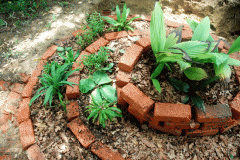
The herb spiral I had built last week in two hours is coming along very well. At a later post, I shall discuss how to build a herb spiral and how the design makes for easy ( low energy ) maintanence.

The tanduk rusa IMO brew is coming along very well too. When we opened the canister, the brew just bubbles over. The pH is an excellent 3.7, and the color has a nice purple tinge to it.
When we rub some of the brew on the palm, one can feel the tingling sensation almost immediately, and it is not the tingling from the bubbles. It is like little spikes. And the palm becomes noticeably reddish, as if the brew draws blood to the palm.

The palm before the brew.
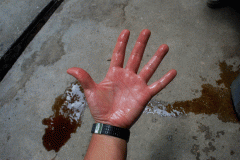
The palm after touching the brew.
Today's highlight was this little bird building a nest in the mulberry bush, right next to the staff kitchen. This shot was taken about 4 feet away and it was not bothered. It is a wild bird and nobody feeds it or anything; we are just too busy. I don't think there are many farms where birds fly around without fear.

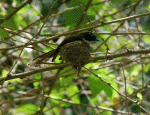
Today's bummer was the continuing heat-wave. The road leading to the farm has become a heat-bank and the grasses lining the road on both sides are burnt from the heat:
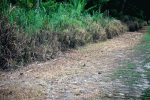

Hope the weather changes soon. The animals are being affected and the workers too are feeling irritable from the continuing heat. Noonday temperature now can hit the low 40s.
22:05 Posted in Blog | Permalink | Comments (0) | Tags: herb spiral, heat wave, platycerium coronarium, mulberry bush
Feb 28, 2009
'Miraculous' Plants at the Farm
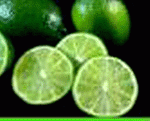
The young green unripe limau nipis,(Citrus Aurantifolia), or key lime, is the most aromatic fruit you will ever taste. We kid you not!!
But you need to first eat one of the berries from this bush - the Miracle Berry bush. 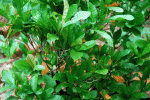 Otherwise the extreme sourness of the limau will shut down all your other senses and you will not be able to experience the aroma. After you chew on the berry,
Otherwise the extreme sourness of the limau will shut down all your other senses and you will not be able to experience the aroma. After you chew on the berry,  the sourness of the limau is ‘smothered’ by sweetness. The limau becomes so delicious you want to finish off the whole fruit and you have to remind yourself what’s happening to avoid a major tummy upset later on.
the sourness of the limau is ‘smothered’ by sweetness. The limau becomes so delicious you want to finish off the whole fruit and you have to remind yourself what’s happening to avoid a major tummy upset later on.

The Miracle Berry Bush
The miracle berry is a bush from West Africa (Synsepalum dulcificum or Richadella dulcifica).
The active ingredient is called Miraculin, which in itself is not sweet, but the tongue, once exposed to miraculin, perceives sour foods such as citrus as sweet for up to a couple of hours afterwards.
 If you chew on the fruit of the lemba or curculi latifolia, plain water and any sour drink will taste sweet. The lemba is found in wet areas of the jungle and we can find them in the jungle next to our farm. The leaves can be used to make ropes and for wrapping things.
If you chew on the fruit of the lemba or curculi latifolia, plain water and any sour drink will taste sweet. The lemba is found in wet areas of the jungle and we can find them in the jungle next to our farm. The leaves can be used to make ropes and for wrapping things. 
There's a patent in the USA (Patent 5378489 ) for the use of the active ingredient, curculin, as a form of sweetener by a team of Japanese scientists.
Don't you think we Malaysians should be ashamed of ourselves for not recognising the value of plants that's growing literally right outside our doorsteps?
23:23 Posted in Useful Plants | Permalink | Comments (0) | Tags: miracle berry, lemba, curculin, miraculin, curculigo, natural sweeteners
Feb 27, 2009
Useful Plants at the Farm - Gliricidia Sepium
This is a plant from Central America, now endemic in Malaysia. It is an inconspicuous and not particularly pretty small tree. You will see it by the road side growing wild. It is known as 'pokok pagar' locally. In our farm, it serves multiple functions.







18:23 Posted in Useful Plants | Permalink | Comments (2) | Tags: medicinal plants, herbal plants, fungicide, animal feed
Useful Plants at the Farm - Cassia Alata
You have most probably noticed this plant at the roadside, especially near earth-drains and low-lying wet areas. It is called Cassia Alata or Gelenggang.

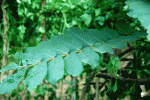

17:32 Posted in Useful Plants | Permalink | Comments (1) | Tags: medicinal plants, herbal plants, fungicide, cassia alata, gelenggang
Feb 23, 2009
Panas Terik - Heat Wave
It's "unseasonal", the heat at our farm lately. Noon day ambient can reach 38 celcius. Chickens stop eating and some drop dead from heat stroke.

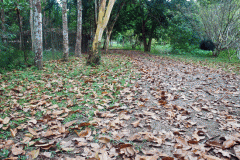

13:04 Posted in Blog | Permalink | Comments (0) | Tags: heat wave, sustainable agriculture
Feb 21, 2009
Organic Tiffin Carrier?
Not exactly, but Calvinn and Adeline do deliver to your homes, home-cooked meals (cooked by Adeline) from mostly organic ingredients. In 2002 they started on a business model of providing a "screening" service for customers, i.e. they make it their business to check out all those food brands and their claims by interviewing the people behind them and then visiting the factories or farms and seeing for themselves how things are done. They can tell you some horror stories. Those brands that meet their high standards will be endorsed by them and delivered to your homes.
We first met them in 2002 and in the years thereafter they never fail to 'check' on us by visiting the farm and checking the nooks, crannies and corners.
They try to lead a LOHAS lifestyle. Their children are home-schooled, and food is mostly organic, whole food and home-cooked.
12:02 Posted in Blog | Permalink | Comments (0) | Tags: home cooked meals, organic, home delivery, lohas
Feb 19, 2009
Tanduk Rusa - Hi-Qi, High Energy Bio Nutrient
Many visitors to our farm have wondered why we have tanduk rusa ( platycerium coronarium or staghorn fern) all over the farm. They are even found on the fruit trees.
The reason is the bacteria in the plant gives out very high beneficial energy. Trees with tanduk rusa are stronger. We harvest these bacteria and spray them on our vegetables, fruits, everywhere, for their beneficial energy:






13:15 Posted in Bio Nutrients | Permalink | Comments (4) | Tags: platycerium coronarium, staghorn fern, qi, bio nutrient, foliar spray, organic, em, imo
Feb 17, 2009
Cold Chain - Don't Lose It!
One of the most important food safety precautions is keeping the Cold Chain intact. Since 2001 when we first started we noticed many fresh poultry suppliers giving scant consideration to this very important food safety concern. The delivery truck is extremely important in our hot climate. Our truck runs at - 5 degrees celcius. Yes, it is below freezing point, but what many suppliers do not realise is that each time the truck stops and unloads, the surface temperature of the meat product is affected, allowing for the growth of bacteria.


17:08 Posted in Chickens | Permalink | Comments (0) | Tags: cold chain, food safety, frozen food temperature, infrared thermometer
Feb 16, 2009
No-Dig Herb and Vegetable Garden - Report No. 1
I have decided to have a no-dig herb and vegetable garden at the farm. Here's my working sketch:
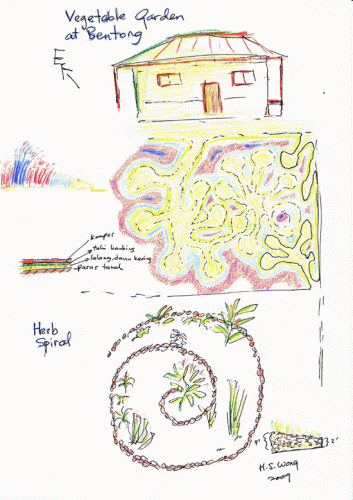
I will build up the soil by first laying down a layer of dried lalang, then some goat dung, followed by compost. To protect the soil and to reduce the need for watering a thick layer of mulch will top off the planting medium. Seeds will be sown directly on to the medium and protected from birds and being washed away by the mulch.
As the vegetables are harvested, we need only top up with compost and dried lalang. There is no need for turning of the soil, no need for fallowing, etc. Season by season, we will build up the soil and it will never be depleted of nutrients.
Here are the result of the first day's work:


I am pretty satisfied with the first day's work. It looks like it is not only going to be productive, but also aesthetically pleasing. The workers will have a variety of vegetables for their meals with minimal input of labour and time.
22:52 Posted in Permaculture | Permalink | Comments (0) | Tags: permaculture, herb spiral, organic vegetable
Feb 12, 2009
Lactobacillus sp. - the Work Horse at DQ Farm
The work horse at our farm is lactobacillus sp. We use farm-caught indigenous lactobacillus and brew an Indigenous Micro Organism brew which is sprayed liberally throughout the farm to enhance the health of plants, animals and humans.

The container on the left is two days old. The curds are seperating out now as the lactobacillus starts to convert the sugars to lactic acid. The one on the right is still new.


The curd (left) is removed after about a week. The curd is then fed to the animals. Some of the staff make a cheese out of the curd.
The yellowish liquid left behind is a concentrate of lactobacillus sp. which will be used to make our IMO spray.

The lactobacillus 'Mother' ready for use. The addition of raw molasses keeps the bacteria alive and prolongs the shelf life to years.
This is one of the ways how we 'disinfect' and how we keep the farm healthy.
14:31 Posted in Bio Nutrients | Permalink | Comments (4) | Tags: lactobacillus, lactic acid, em, imo








